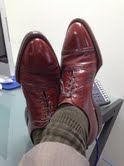#1 2011-03-01 01:29:04
- The_Shooman
- A pretty face

- From: AUSTRALIA
- Posts: 13191
Vass HAF sole (part II) - it IS unbalanced!
Last edited by The_Shooman (2011-03-01 03:05:34)
#2 2011-03-01 03:54:22
- meister
- Member

- Posts: 1141
Re: Vass HAF sole (part II) - it IS unbalanced!
Interesting Shooey PM in the box for U
#3 2011-03-01 18:56:50
- The_Shooman
- A pretty face

- From: AUSTRALIA
- Posts: 13191
Re: Vass HAF sole (part II) - it IS unbalanced!
Last edited by The_Shooman (2011-03-01 19:14:59)
#4 2011-03-02 06:57:23
- interested observer
- Member
- Posts: 65
Re: Vass HAF sole (part II) - it IS unbalanced!
For any given last/insole/outsole combination, there is only ONE correct heel height: the one that makes the outsole touch the ground with the treadline at the joints. From the picture, it looks like your 'modified' heel throws the treadline too far forward, past the joints -- though that could be an artifact of the picture's angle.
That being said, adding a haf sole does necessitate a higher heel than a heel on a single sole on the same last, as the outsole across the correct treadline is thicker, and thus the heel must be raised to keep the treadline at the proper location relative to the ground. In essence, one needs to add a layer to the heel equivalent to the thickness (at the treadline) of the haf sole.
Another way to check is the toe spring: the toe spring -- the distance of the outsole from the ground at the end of the shoe -- should be the same on all shoes made on the same last, regardless of the thickness of the outsole, be it single, double, or haf.
Depending on how and where one defines 'heel height' -- from the ground to the bottom of the outsole, from the ground to the top of the outsole/bottom of the upper, at the back of the heel, at the front/breast of the heel -- will determine the correct heel height for any last/outsole combination. However, it is generally NOT correct to say a single sole will require a higher heel than a double sole, even given the definitional uncertainty in using the term heel height.
Last edited by interested observer (2011-03-02 07:02:53)
"Any formal attack on ignorance is bound to fail because the masses are always ready to defend their most precious possession - their ignorance. "
— Hendrick Van Loon
Better to be thought a fool than to speak and remove all doubt.
#5 2011-03-02 07:22:38
- The_Shooman
- A pretty face

- From: AUSTRALIA
- Posts: 13191
Re: Vass HAF sole (part II) - it IS unbalanced!
Last edited by The_Shooman (2011-03-02 08:19:43)
#7 2011-03-04 21:43:53
- interested observer
- Member
- Posts: 65
Re: Vass HAF sole (part II) - it IS unbalanced!
"Any formal attack on ignorance is bound to fail because the masses are always ready to defend their most precious possession - their ignorance. "
— Hendrick Van Loon
Better to be thought a fool than to speak and remove all doubt.
#8 2011-03-05 10:00:43
- Cruz Diez
- Member

- Posts: 1950
Re: Vass HAF sole (part II) - it IS unbalanced!
^ same sole thickness, different heel height.
Sorry, I am a bit skeptical about all this overanalyzing... I think you're the guy who once said that one of my GG bespokes had "crude" sole stitches. Perhaps that explains my skepticism.
Last edited by Cruz Diez (2011-03-05 10:06:19)
#9 2011-03-05 15:40:28
- interested observer
- Member
- Posts: 65
Re: Vass HAF sole (part II) - it IS unbalanced!
"Any formal attack on ignorance is bound to fail because the masses are always ready to defend their most precious possession - their ignorance. "
— Hendrick Van Loon
Better to be thought a fool than to speak and remove all doubt.
#11 2011-03-06 05:20:49
- interested observer
- Member
- Posts: 65
Re: Vass HAF sole (part II) - it IS unbalanced!
Bone structure, which determines your joint location, does not change during the day. It is the girth/volume of the foot that changes during the day. Any variation in sock thickness does not change the contact point of your foot significantly, although a foot tracing and measurements should be done with representative socks on, as they affect girth more significantly. A good lastmaker, when doing the tracing, can also easily feel where your joint is actually located -- this point is marked on the tracing. Finally, things such as a correctly taken foot imprint quite clearly show the locations of the joints.
You may think correct heel height is not important, and, certainly, variations therein are unlikely to cripple you or otherwise injure your feet. Still, in this regard, there is a 'right' way to make a heel and all other ways. You may not care, but ask anyone trained about shoe and lastmaking about heel height.
For example, next time you meet with an experienced, well trained lastmaker, ask him. Get back to us on his reply, will you?
"Any formal attack on ignorance is bound to fail because the masses are always ready to defend their most precious possession - their ignorance. "
— Hendrick Van Loon
Better to be thought a fool than to speak and remove all doubt.
#13 2011-03-06 07:40:47
- fritzl
- Member
- From: Gmunden, Salzkammergut/Austria
- Posts: 849
Re: Vass HAF sole (part II) - it IS unbalanced!
"I'd give all the Champagne I've ever drunk to be playing alongside him(Eric Cantona) in a big European match at Old Trafford." George Best(1946 -2005)
#14 2011-03-09 07:28:11
- JDelage
- Member

- From: Seattle, WA
- Posts: 673
Re: Vass HAF sole (part II) - it IS unbalanced!
What does HAF stand for? HAlf-to-Full?
